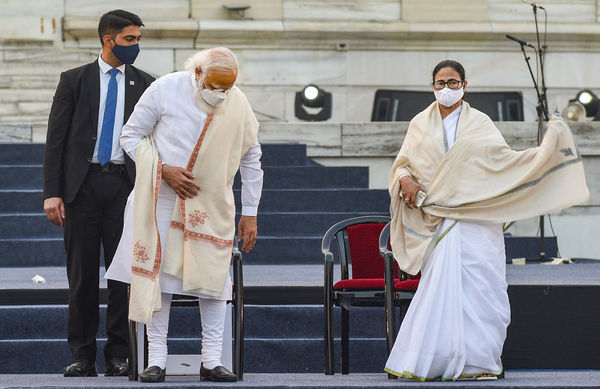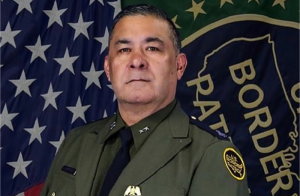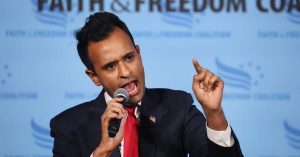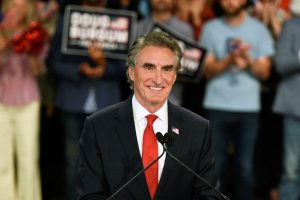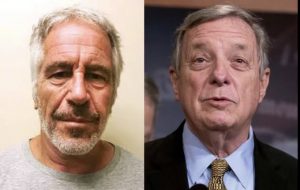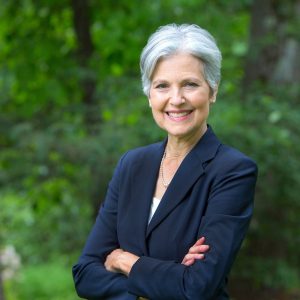As four states and a Union Territory — West Bengal, Assam, Tamil Nadu, Kerala, Puducherry — vote to elect new assemblies, everyone is looking at the outcome of the vote in terms of what it means for the Lok Sabha polls of 2024. The underlying assumption is that the winners will determine who gets to challenge Prime Minister Narendra Modi and the BJP three years from now.
It is because of this linkage between what happens in Bengal and Assam and the Lok Sabha elections, the stakes have shot up for the major parties and their leaders.
Bengal accounts for 42 Lok Sabha seats while there are 14 seats in Assam. Beyond that number, any party that runs governments in these states will have a large say in the parties’ electoral fortune in the next Lok Sabha elections.
Also read: Stalin-led DMK now faces an uphill task because Sasikala won%u2019t play spoilsport for AIADMK?
In fact, chief challengers and defenders in the respective states have gone about the campaign with this idea that whoever gets to form the next government, gets a big advantage in these elections.
If Mamata Banerjee succeeds in retaining power in Bengal for the third time and keeping the BJP at bay, she would emerge as a sort of giant killer ready to take on Modi. She could be a key opposition leader who could be in a pivotal position to challenge the BJP%u2019s domination in the national politics since 2014– when the PM steered it to power at the centre and in many states subsequently.
It will also prove that Mamata has single-handedly managed to keep the Trinamool Congress afloat despite desertions by many senior colleagues and MLAs in favour of the BJP.
Conversely, the collapse of the Mamata-led regime and the BJP coming to power in Bengal and its return to office in Assam will be more cataclysmic for the opposition. Modi would stand undiminished and even further strengthened to steer the BJP ahead.
Therefore, it is not at all surprising that Bengal has witnessed a very high-voltage campaign by Modi, Amit Shah and Mamata, and many other leaders. So has Assam.
In fact, Nandigram, which went to the polls only in the second phase of voting in Bengal on April 1, epitomises Mamata’s battle against the BJP. Once the symbol of Mamata-led rural voters%u2019 uprising against the 34-year-old legacy of the Marxist rule, Nandigram has characterised the BJP%u2019s strategy to build its base by encouraging Mamata%u2019s former aides like Suvendhu Adhikari to revolt against her.
Mamata’s bid to foist her nephew or %u201Cbhaipo%u201D and Lok Sabha MP Abhishek Banerjee as her political heir has come handy for the BJP.
A lot of drama got added to the campaign when Mamata injured her leg when the door of the car in which she was travelling slammed during a roadshow in Nandigram after she filed her nomination against Adhikari on March 10, for which she blamed her political rivals.
Also read: What do upcoming Assembly polls mean to PM Narendra Modi and BJP
Of course, sensing an opportunity, Mamata shifted to a wheelchair campaign in the hope of earning more sympathy and brownie points for herself and scorn for the BJP.
Not to be outdone, Modi and Amit Shah too have hit the campaign trail, sharing between them the burden of convincing the population of the BJP’s ability to usher in %u201Cashol parivorton%u201D (real change) in contrast to what Mamata%u2019s %u201Cparivorton%u201D failed to achieve since she came to power in 2011.
As a crowd puller for the BJP, Modi has gone for big rallies with a pledge to build ‘Sonar Bangla’ (prosperous Bengal). Shah has preferred roadshows through even small towns which were once the strongholds of the Trinamool Congress in south Bengal.
In fact, Modi has slammed Mamata for following “appeasement and vote bank politics,%u201D using her “khela hobe (game on)” phrase.
Addressing a rally in Purulia, Modi held her government responsible for infiltration in the state alleging that her game that she %u201Cplayed%u201D for 10 years would be soon over and development would begin. “Didi, O Didi – you played for 10 years. Khela shesh hobe, vikas aarambh hobe. (Now your game will be over, and development will begin),” he said.
Mamata has termed the Modi government as very %u201Canti-people,%u201D citing its track record in creating jobs, and failure to check fuel price hikes to counter the BJP%u2019s hard-hitting narrative on her system of governance, with allegations of extortions and prevalence of %u201Ccut money%u201D even in social schemes meant for the poor.
Also read: Battle for Bengal: PM & BJP go for final push but Mamata has a lot more to worry about
The voting that begins on March 27 will see a maximum of eight phases in Bengal that ends only on April 29. The first phase will cover 30 of the 294 assembly seats, which are spread across tribal-dominated Purulia, Bankura, Jhargram, Purba Medinipur (Part 1) and Paschim Medinipur (Part 1) districts. These areas were considered the citadel of the Left before Mamata%u2019s party gained grip after the 2011 polls.
In Assam, the first phase covers 47 of the 126 assembly constituencies, mostly located in the upper parts of the state. A major issue that has put the BJP on the defensive here is the Citizenship Amendment Act (CAA), which was brought by the Modi government to grant Indian citizenship to non-Muslim refugees. Upper Assam, which has seen a steady influx of Bangladeshis over the years, has been witness to violent agitation against all foreigners, whether they are Hindus or Muslims. So, the BJP has been silent on the CAA issue but promised to rectify the botched up National Register for Citizens (NRC).
In 2016, the BJP, Asom Gana Parishad (AGP) and Bodoland Peoples%u2019 Front (BPF) had formed an alliance. The BJP bagged 60 seats, AGP 14 and BPF 12 in the 126-member assembly. The Congress, which was then led by the then chief minister late Tarun Gogoi was victorious on 26 seats. Perfume-king Badruddin Ajmal-led All India United Democratic Front (AIUDF) had contested separately and won13 seats.
In 2021, however, the BJP and the AGP are contesting as an alliance but BPF has joined a mahajoth (grand alliance) of the Congress and the AIUDF. This is the first time Congress and Ajmal have gone for an open alliance, along with Anchalik Gana Morcha and three Left parties, to avoid a split in the anti-BJP votes.
Also read: Despite political challenges, Modi is keen on reforms in key sectors including agriculture
The constituencies in the first phase are located in the tea-rich belt. Out of the 47 constituencies, going to polls in the first phase on March 27, 38 fall in the tea districts of Jorhat, Golaghat, Sibsagar, Dibrugarh, Tinsukia, Bishwanath and Sonitpur. About eight lakh workers in 850 gardens of the state are solid votes for any party. The BJP and Congress have tried their best to woo the tea-tribe community whose votes play a decisive role in 35-40 seats.
The Congress has also announced a guarantee of increasing the daily wages of tea garden workers from Rs 167 to Rs 365.
Congress leader Priyanka Gandhi Vadra visited tea gardens, interacted with the workers and even went to their huts, and posed for photographs. She was seen plucking tea leaves with a basket held with a strap over her head, like the tea garden workers do. The BJP ridiculed it as a “photo op session during the off-season when leaves are not plucked.
BJP%u2019s chief minister Sarabanda Sonowal is seeking re-election from Majuli, a seat he wrested from Congress’ Rajib Lochan Pegu in the 2016 Assembly elections. Pegu, who had won the seat for three terms since 2001, has again been fielded by Congress. Sonowal%u2019s return as CM depends on the BJP gaining good numbers. In case of a hung house, his deputy Hemanta Biswa Sarma may hold the reins of the next BJP government.
#MamataBanerjee #NarendraModi #BJP #TrinamoolCongress #Politics #WestBengalElection2021 #WestBengal #AssemblyElections #India

